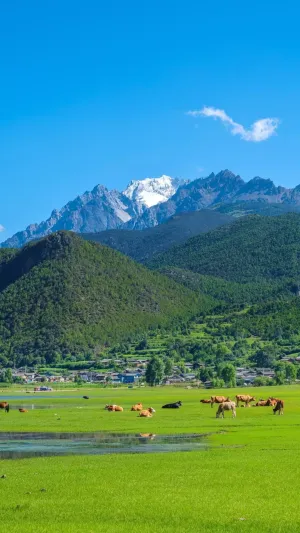Animal husbandry refers to the production sector that raises livestock and poultry to obtain animal products through grazing, captive breeding, or a combination of the two.
Pastoral grazing is a market-oriented type of agricultural territory and is mainly distributed in Australia, New Zealand, the United States, Argentina, the United Kingdom, and other countries and regions.
These areas have large of pastures suitable for grazing livestock, thus forming this type of agricultural territory.
Australia's natural pastures account for 55% of the country's total land area, ranking first in the world. Australia has the reputation of "the country riding on the back of the sheep" and is an important producer and exporter of mineral resources in the world.
Dairy cows are mainly raised on natural pastures and large farms. The geographical location of these farms is superior--they are located in the cool and moderate natural environment of the temperate tropics. High-quality forages give the dairy industry a healthy development and are welcomed by the global market.
Agriculture and animal husbandry in Australia occupy an important position in its national economy, and animal husbandry is very developed. Australia's agriculture and animal husbandry are in a leading position in the world, and its advanced feeding technology, services, and skills have been exported to many countries and regions.
New Zealand is one of the largest livestock countries. As early as the 1990s, New Zealand wool reached an annual output of 250,000 tons. Today, this land contributes a quarter of the world's wool production.
The average temperature in New Zealand in summer is approximately 20 degrees Celsius, and in winter is around 10 degrees Celsius. At the same time, New Zealand has plentiful precipitation. The average annual rainfall across the country is 600 to 1,500 mm, and the air humidity is also very high. Such plentiful rainfall and small temperature differences are very conducive to pasture growth and animal reproduction.
The United States has a land area of 9.37 million square kilometers, with plains below 500 meters above sea level occupying 55% of the total land area. The country's natural grassland area represents 26.5% of the total land area and 7.9% of the world's natural grassland area, which ranks it third in the world.
U.S. livestock production is distributed in a zonal pattern. Animal husbandry production is distributed in belts, such as the dairy animal husbandry belts in the northeast, north, and central regions, which concentrate 70% of the dairy products in the United States.
Argentina is a country that has a large animal husbandry industry, mainly concentrated in the Pampas grassland. Sheep farming is the most developed area of this industry. According to statistics, the number of sheep in the Pampas grassland has reached 60 million. Argentina's favorable environment has contributed to the growth and development of its animal husbandry industry, making it one of the top meat exporters in the world. It is commonly referred to as the world's meat bank.
According to statistics, the UK's pasture area is close to half of the total area of the country. Of this, the area planted with feed for animal husbandry accounts for half of the country's arable land, and a large area of arable land is used to grow forage grass.
One of the characteristics of British animal husbandry is the large pasture area. British milk powder is of excellent quality and has gained the trust of domestic and even worldwide consumers. This is because British animal husbandry is highly developed. An important manifestation of the development of animal husbandry is the high level of mechanization and standardization, which enables it to provide a steady stream of high-quality dairy products to the global market.





